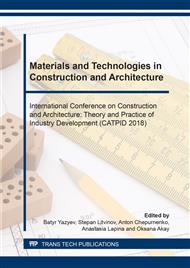p.280
p.288
p.295
p.300
p.304
p.311
p.315
p.321
p.328
Crack Strength and Deformability of Power Transmission Line Conical Poles
Abstract:
Numeral experiments to study influence on design strength of conical poles, limitations of crack width and breaking strain have been conducted. The analysis of influence on conical poles crack strength and deformability and relation between areas of prestressing steel and total area of steel (Asp/As,tot) has been performed. Research has revealed that dependence of crack width on relation between Asp/As,tot for all types of conical poles is close to linear. Percentage of reinforcement μs, tot % does not influence this dependence. A moment of force increase caused by vertical load Mv/M leads to a significant increase of crack width. Presence of prestressing steel (Asp/As,tot) has the greatest influence on the deflection of conical poles. Still total percentage of reinforcement has little influence on a type of function fпр=f (Asp/As,tot). Calculations of poles made according to a strain pattern showed that regulations understate approximate value of deflection. For that reason, it is advisable to make calculations of poles CONS22, CONS26 according to a strain patter.
Info:
Periodical:
Pages:
304-310
Citation:
Online since:
September 2018
Price:
Сopyright:
© 2018 Trans Tech Publications Ltd. All Rights Reserved
Share:
Citation:


